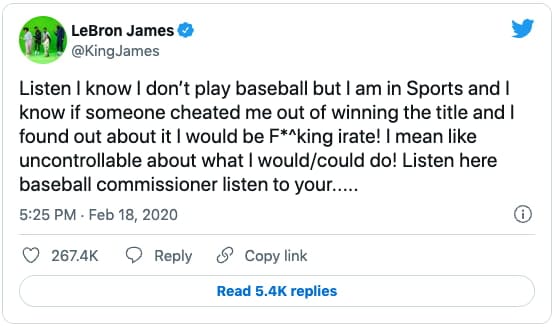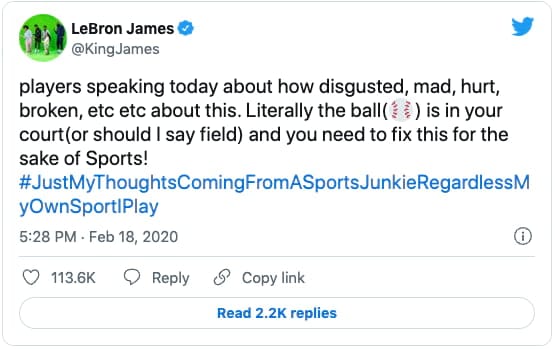Using the right hashtags at the right time can make a huge impact on your social media strategy by helping users find content that is relevant to them.
On Tuesday February 18th 2020, around dinner time, LeBron James dropped these controversial tweets.


While most people were debating the baseball cheating scandal that James was weighing in on, here at Y, we were discussing his hashtag usage.
When LeBron used the hashtag #JustMyThoughtsComingFromASportsJunkieRegardlessMyOwnSportIPlay he was doing something we wouldn’t recommend for a social media strategy. He was using a hashtag in a very un-hashtag way.
It was a hashtag designed for one time use. He used it as a way of acknowledging some of the criticism that would be coming his way. It reminded us of the way hashtags were used in their infancy. Today, however, hashtags are used very differently.
Today, hashtags are used to organize subjects, for people to follow a topic that they are interested in, and to allow brands to get in front of interested people. So when you use the hashtag #JustMyThoughtsComingFromASportsJunkieRegardlessMyOwnSportIPlay, there is no audience for it, no one following it, unless you happen to be LeBron James and then it becomes a trending hashtag! For the rest of us, it’s a bad idea.
LeBron’s tweet shows us that hashtags still matter – perhaps more so now than ever. Here are some important reasons to use hashtags in your social media strategy, how to use them, and some helpful tools to find the best hashtags for your business.
Why Use Hashtags in Your Social Media Strategy?
Topics of Interest: The main use of hashtags is to help people find specific posts or topics that interest them. A hashtag organizes all posts in one place, making it easy for a user to see what they are interested in.
Expand Your Audience: Hashtags can help brands and marketers reach a wider audience, generate more engagement on their posts, and get more followers for their accounts.
Monitor Audience: Hashtags also allow you to monitor what your audience is interested in. You can easily search hashtags that are popular in your industry, then look at what related topics people are talking about. For example, a fitness-related hashtag may have multiple interests branching off from it, like exercise, nutrition, and healthy sleep habits.
How To Use Hashtags
Be Memorable: That Lebron hashtag breaks this rule. Use a hashtag that people can remember. TBT is far easier to write and remember than ThrowBackThursday.
Be More Than A Brand Name: Avoid using just your brand name as a hashtag. If you want to use a branded hashtag, come up with a unique one. When Always used #LikeAGirl, it was a perfect example of something that is associated with a brand, but has far more meaning for people beyond the brand. Speaking of branded hashtags…
Be Generous: Hashtags are perfect for contesting. Tying a branded hashtag to a great prize helps your business increase followers, engagement, and encourages brand loyalty.
Be Prepared: Before you start using hashtags, have a strategy. All good strategies are based on research. There are lots of free tools to help you. More on those later.
Be Relevant: Pick hashtags that are relevant to your brand. See what hashtags your followers are using and borrow some of those. Make sure to focus on smaller, niche hashtags that appeal to your audience. For example, using a large hashtag like #running may result in your post being lost in the shuffle within minutes. However, a hashtag like #TrailRunningCanada may have far less usage, but may be more appealing to your audience and result in more engagement for you.
Be Consistent: A critical ingredient of hashtags success on social media is consistency. Use the same hashtags across all channels, especially branded hashtags.
Be Fresh: Consistency does not mean copying. Don’t copy paste the same set hashtags in each post. Use only relevant hashtags for what you are posting.
Be Accessible: Capitalize the first letter of each word in a multi word hashtag so that people who use screen readers can understand what you’re saying.
Free Tools For Hashtag Research
If you are wondering what hashtags to use on your social channels, these free tools are all helpful in generating ideas.
Hashtagify: If you are on Twitter, Hashtagify is a great tool. Find related hashtags, their popularity, and how hashtags are trending.
Instavast: This is a great tool for Instagram users. It displays data for related and niche hashtags. It is easy to use and provides great ideas for hashtags.
Display Purposes: Another Instagram hashtag generator that is easy to use. It also has a map function to search for local hashtags.
Seekmetrics: This Instagram and Twitter hashtag generator provides 30 of the best hashtags to use on any topic you search.
TrendsMap: Explore Twitter’s trending hashtags by regions with this map-based tool.
How Many Hashtags Per Channel
Twitter: One or two. With only 280 characters, space on Twitter is limited. One or two hashtags that are relevant or trending are great, more than that and you are using up valuable characters.
Instagram: You can use up to 30 hashtags. Use as many as are relevant to your post. Remember that you can place those hashtags in the comments and they remain searchable.
Facebook: There is some debate here. Data from Buzzsumo says that posts with hashtags get less engagement. However, if there is a relevant hashtag that you want to post about (like a burger restaurant using #NationalHamburgerDay on May 28th) then go for it. But you do not have to use them in every post.
LinkedIn: Less is more on LinkedIn as well. As a professional network, one or two hashtags related to your industry is sufficient.
Using the right hashtags can make a huge impact on your social media strategy. Start with research, using the tools that we outlined above. Organize relevant hashtags into logical groupings. Then, start using them. See what provides results. Don’t be afraid to experiment. Review data, see what is working, research, and continue optimizing your strategy.
Looking for social media strategy to help increase your brand’s digital presence and engagement, contact Y to see how we can help.


